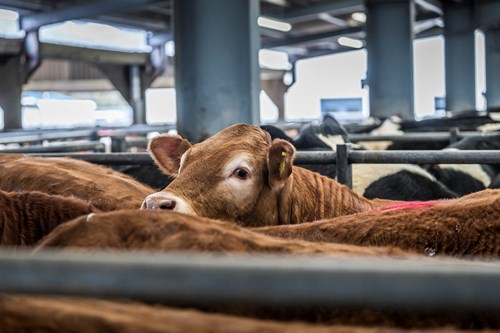Quarantine for Bought in Stock

This time of year, sees many beef and sheep farmers buying in breeding stock, with various sales taking place across the country. Whether you are buying a new stock bull or stock tup, replacement heifers, ewe lambs or gimmers, you risk bringing disease onto your farm. Buying in any stock can pose as a significant health risk to your herd or flock. Ideally plan ahead and buy in as few animals as possible, from as few herds/flocks as possible. Quarantine of newly purchased animals, if done correctly, is a key step in reducing the risk of disease transfer between existing stock and any new stock. Remember this works both ways – it is possible for stock already on farm to infect new arrivals.
How long should purchased animals be kept in quarantine before they are introduced to other stock?
Animals should be quarantined and kept separately from other stock for at least 21 – 28 days. The length of quarantine time will depend on the diseases being screened for or treatments required. For example, if cattle are from a high-risk TB area, they are required to be tested 60 days after arrival on farm, therefore the quarantine period is at least 60 days.
Speak to your vet and discuss quarantine protocol as part of health planning for your herd or flock.
Where to quarantine stock?
The quarantine area and or field needs to be big enough to keep all the new stock in for the quarantine period. Ensure that fields are fully stock proof and there is no risk of nose-to-nose contact with other stock.
Newly purchased sheep should be housed or put on pasture that will not be grazed by your own flock. It is possible for some diseases – e.g. sheep scab to be transmitted through handling facilities and trailers so ensure a disinfection protocol is in place.
Incoming stock should be housed in a separate building from existing stock so to ensure that the same airspace is not being shared between groups. No direct contact should take place between purchased animals and their by-products (faeces and urine) and the existing herd. Also think about where the dung and urine are going to, because these can transmit diseases; for instance, the animals may be in a separate shed, but if their by-products are in contact with where your existing stock is, these animals are at risk.
What diseases should be tested and treated for?
Many of the disease threats are not visible, so protection relies on a combination of treatments and testing.
The diseases needing tested for will depend on which diseases are already present within the herd or flock. Screening will depend on the individual farm situation therefore discuss with your farm vet the best approach.
Key diseases to be aware of for cattle include Bovine Viral Diarrhoea (BVD), Johne's Disease, Infectious Bovine Rhinotracheitis (IBR), Leptospirosis, Neospora and Campylobacter. Discuss with your vet whether testing or treatment for external parasites (ringworm and lice) and internal parasites (gutworms, lungworm and liver fluke) is appropriate. Ensure that vaccinations are in line with the rest of the herd.
Anthelmintic resistance is a growing issue within flocks. Purchased sheep have the potential to introduce both resistant worms and fluke and new species of worm. Discuss quarantine treatments and procedures for isolation with your vet. Further useful information can be found here.
What to look for when carrying out a visual/physical assessment?
The quarantine period should be used to keep a close eye on stock. Key things to look for are, body condition, coughing, nasal discharge, and signs of skin disease, such as ringworm in cattle and scab in sheep.
Sheep which become lame during the quarantine period should be examined. Footrot and Contagious Ovine Digital Dermatitis (CODD) cause lameness and can be difficult to control. If footrot or CODD is identified, then sheep should be treated, and the lameness resolved before these sheep enter the flock. After the quarantine period has ended it is beneficial to graze these incoming sheep separately, to continue to assess for signs of lameness.
With the recent autumn bull sales just past, herds may have purchased a new stock bull. Ideally bulls should be purchased from a herd that has a known health status. These herds will have undergone regular testing to become accredited free of diseases such as BVD or IBR or have a low risk level for Johne’s Disease. Discuss with your vet about if further quarantine/testing/vaccination is needed. Remember that if bulls are bought through a market, or if they share transport, they could have acquired infection just before arriving on your farm therefore quarantine and testing will be necessary, even if they are from a herd with a high health status.
Campylobacter can be carried onto your farm in the sheath of infected bulls and can cause fertility problems. Sexually inexperienced bulls are low risk, however if the bull has been used previously, consider asking your vet to carry out a sheath wash during the quarantine period to check for Campylobacter.
Consider semen testing the bull to ensure that the bull is fertile and there are no sperm abnormalities. Remember there is funding available (up to £250) for bull fertility testing through the Preparing for Sustainable Farming (PSF) Animal Health and Welfare options up until the end of the year.
Fertility testing could potentially identify a sub-fertile bull ahead of the breeding season and alleviate the costs of keeping a sub fertile bull through the winter.
Sarah Balfour, Beef Consultant, sarah.balfour@sac.co.uk

Unearthed is the exclusive SAC Consulting members' monthly newsletter. Unearthed offers insights and tips from our experts on what we think is in store for farming and crofting in the coming months in order to protect and enhance your business.
Posted by Unearthed News on 16/10/2024
